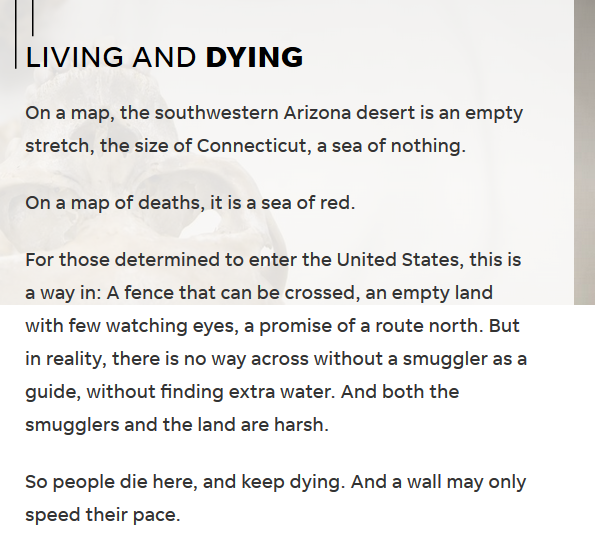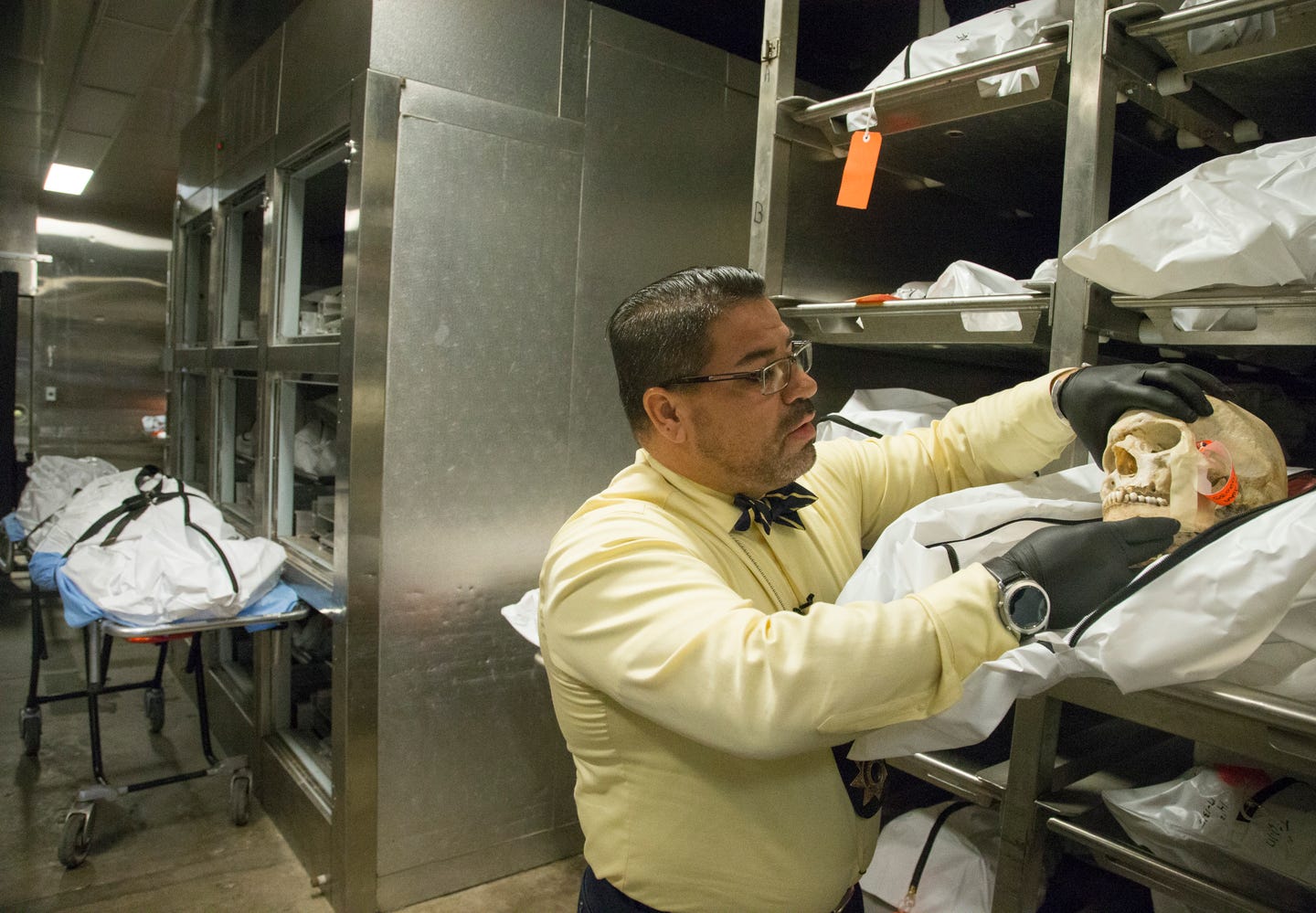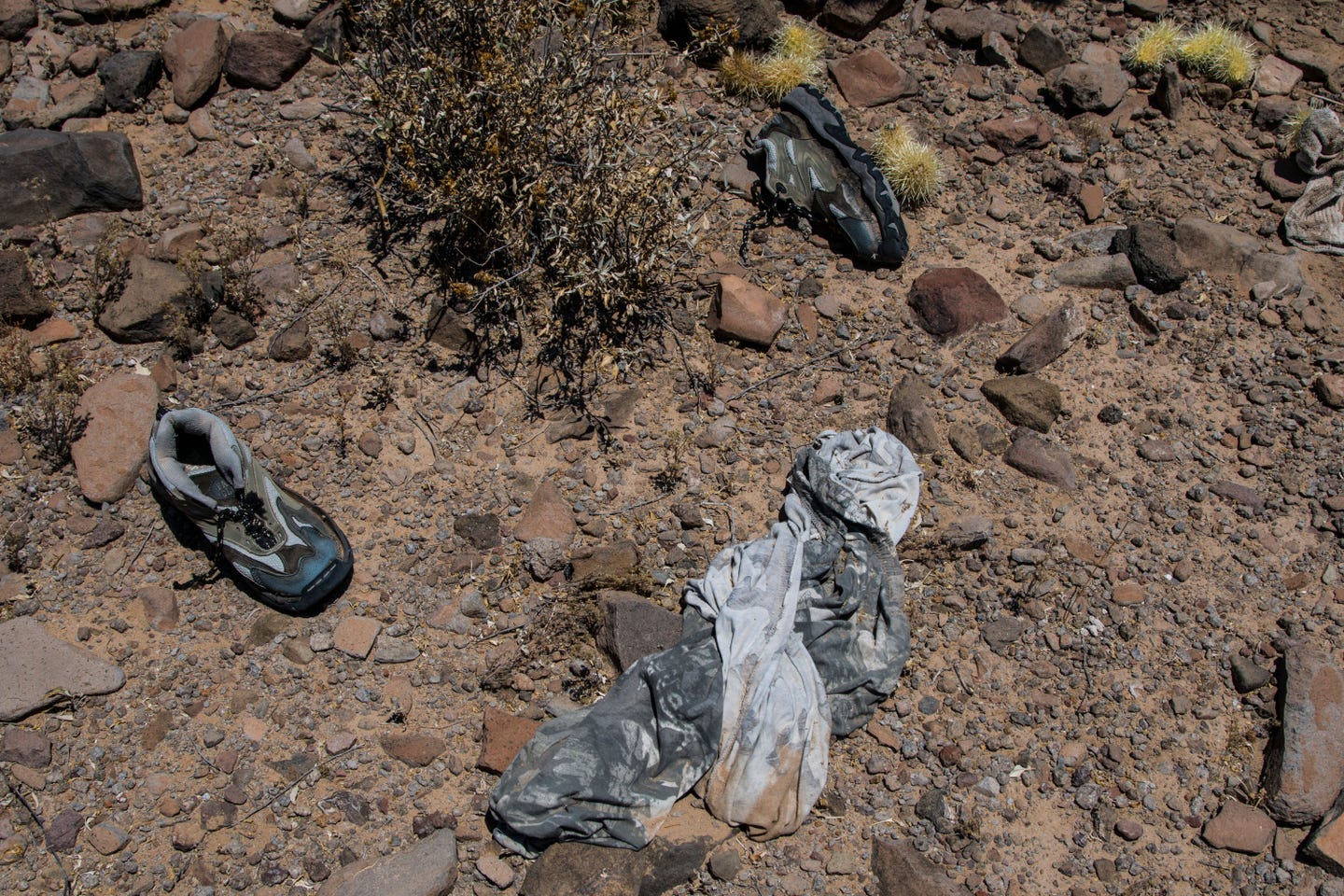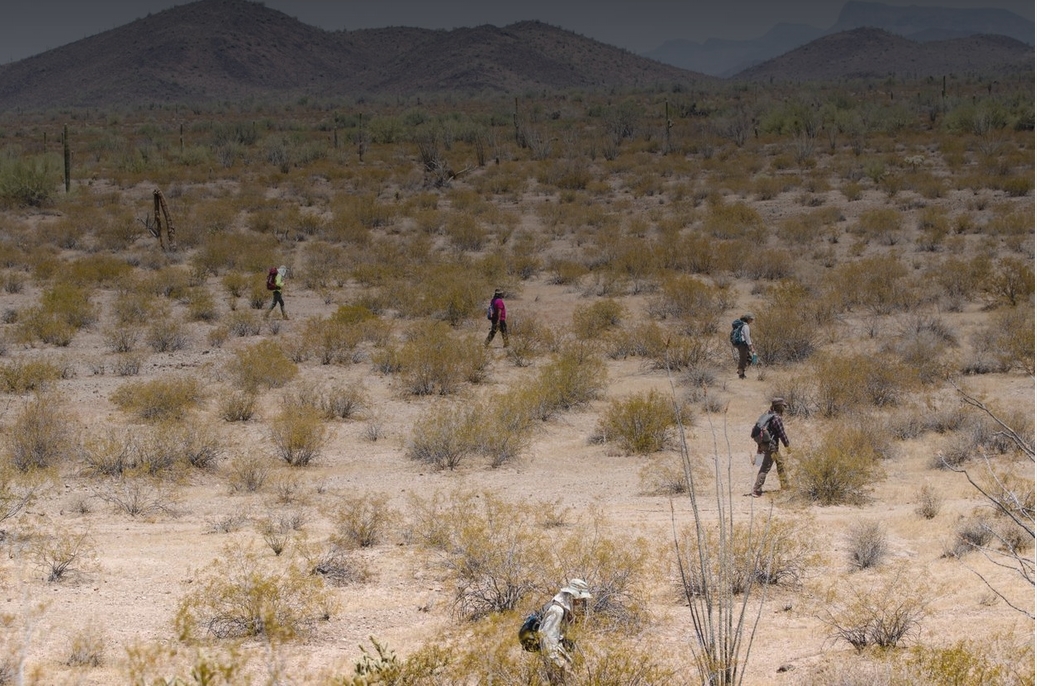The Wall - A Video of death in the Arizona desert.
Post# of 65629


https://www.usatoday.com/border-wall/story/im...608910001/
Border crossings: A deadly desert: More barriers along the Mexican border can force illegal immigrants to cross in more desolate areas.
Deaths increasing: The remains of 81 migrants have been recovered in southern Arizona in 2017 as of the end of June.

https://www.azcentral.com/story/news/politics...575080002/
Organ Pipe Cactus National Monument, Arizona
Border crossers, and the desert that claims them
Daniel Gonzalez | azcentral.com | USA TODAY NETWORK
As she climbs out of the truck, it’s clear Selene Ramirez has never hiked in the desert.
Her flimsy sneakers are no match for the thorny cholla pods that easily pierce foam-rubber soles.
And as she shoulders her small backpack, it is obvious Ramirez is not carrying enough water for a nearly five-hour trek on a day when the late-June temperatures will soar to 108 degrees.
But out there in the desert is a corpse. Several migrants passing through the area, a well-traveled route for illegal immigration, have reported seeing it. They say it’s near a dirt road south of Kino Peak, a tooth-shaped mountain formation nicknamed La Muela, the molar.
Ramirez fears it’s the body of her 25-year-old brother, Carlos Martinez. He became sick after crossing the border illegally in mid-June. In the area where he crossed, there is no border wall, something President Donald Trump has vowed to build to halt unauthorized migration.
If the corpse is her brother’s, Ramirez is determined to find it and end the agonizing uncertainty her family has endured since Martinez went missing.
“It’s killing us,” she says. “The not knowing is the worst part. Not knowing if he is alive or if he is dead.”
In her purse, she carries her brother’s Mexican voter card. The photo on the ID, she hopes, will be useful should she find a body. By now it would surely be badly decomposed.
“Some people view them just as illegal immigrants trying to cross the border. They don’t realize they have families, families that care about them,” Ramirez says as she takes her first steps into the furnace-like heat, seeking answers.

Investigator Gene Hernandez shows the skull of one of 135 unidentified migrants whose remains fill the cooler at the Pima County Medical Examiner's Office in Tucson, Arizona.
The remains of at least 2,832 migrants have been found in southern Arizona since 2001, according to the Arizona OpenGIS Initiative for Deceased Migrants. Nearly 40 percent (1,089) have never been identified.
The initiative, a joint project between the Tucson-based group Humane Borders and the Pima County Medical Examiner’s Office, plots on an interactive map the location of every deceased migrant who has been found. There are so many red circles on the map, southern Arizona resembles a sea of blood.
But the area wasn’t always a vast graveyard for migrants, says Chelsea Halstead, deputy director of the Colibri Center for Human Rights.
Founded in 2006, the center’s Tucson offices are in the same building that houses the Pima County Office of the Medical Examiner.
That puts Halstead steps away from the receiving area for the remains of migrants found in the desert.
The Colibri Center collects DNA samples and other information to identify those remains.
Prior to 2000, fewer than five dead migrants were found in southern Arizona each year, according to the OpenGIS data.
But the number soared to 79 in 2001, as illegal immigration from Mexico to the U.S. surged and increased border security in California and Texas funneled more migrants through more remote and dangerous routes in Arizona.
The peak came in 2010, when 224 remains were found.

Since then, Border Patrol apprehensions, a proxy for the number of people crossing illegally, have plummeted. Still, the number of dead migrants found each year remains high, with 169 recovered in 2016, according to the OpenGIS data.
The data shows that while fewer people are crossing illegally, more are taking riskier routes through more treacherous terrain, Halstead says.
“What we know is that people will find a way (to get across) whether there is a wall or not," Halstead says.
“What we can predict with this is just that more people will be put in harm’s way … and more of them are going to die in the desert.”
In July, several weeks after her brother went missing in mid-June, Ramirez reported her brother missing to the Colibri Center. At the time Ramirez reported her brother missing, the center had 2,454 open cases of missing migrants border-wide reported by family members.
Since 2006, the center's Missing Migrant Project has helped close the cases of more than 100 migrants found dead by helping identify their remains through DNA testing and other means, Halstead says.
Of those migrants, about 1,560 were reported missing in Arizona, 286 in Texas, 80 in California and four in New Mexico. The rest had gone missing along the border, but it was unknown where.
Carlos Martinez had lived in Arizona almost his entire life, Ramirez says. Their mother brought him to the U.S. illegally when he was 9 months old. Ramirez was born in Phoenix four years later, making her a U.S. citizen.
Ramirez says her brother considered Arizona home. He had “AZ” tattooed on his left shoulder inside an outline of the state. She describes him as funny and caring, often stopping to give his fast-food meal to homeless people on the street.
But in 2016 her brother was deported.
It was the second time he had been deported, after he was caught in the U.S. illegally, according to Immigration and Customs Enforcement officials. He was deported first in 2010 after pleading guilty that year to a misdemeanor charge of marijuana possession and separately to a felony charge of unlawfully discharging a firearm, ICE says. The firearm charge occurred when Martinez was 17, court records show.
Their mother had moved back to Cananea, Sonora, years ago. After Martinez was deported, he moved in with their mother, Ramirez says. But he yearned to be back in Phoenix.
“He just didn’t want to be in Mexico anymore,” Ramirez says. “He didn’t like it. He didn’t feel familiar.”
But re-entering the U.S. illegally after being deported is a felony. And as a convicted felon if caught again, Martinez would face up to 20 years in federal prison — which might explain why he decided to take such a remote and dangerous route.
At the time he crossed, Martinez was living with friends in Sonoyta, a town in Sonora across from Lukeville, the last stop in the U.S. on the way to Puerto Peñasco, a beach town also known as Rocky Point.
Before crossing, Martinez stocked up on food and plastic gallon jugs of water. He also bought a camouflage shirt, pants and hat, says Patricia Perez, a 42-year-old Phoenix resident who owns the store. As a gift, she gave him a package of Fruit of the Loom underwear from her store.
Her family was friends with Martinez when he lived in Phoenix. She rented him an apartment in Sonoyta before he left.
Martinez told her he was going to cross the border with a group of eight or nine others.
Most likely he crossed near the kilometer 19 marker on Mexico Highway 2, a well-known departure point about 12 miles west of Sonoyta, after being dropped off there by smugglers.
This part of the border is divided by shoulder-high metal barriers welded together from old railroad tracks. The barriers are designed to prevent vehicles from driving across, not people. They are easy to climb over.
What’s more daunting is the other side. It's an 80-mile journey to Gila Bend, the most common smuggling destination. The hike through mountainous desert terrain can take seven to 10 days.

Selene Ramirez of Phoenix rests in the July heat while searching for the body of her brother, Carlos Martinez, 25, near Ajo, Arizona. He went missing after crossing the U.S. border illegally.
Two days after Martinez crossed, Ramirez received a call from one of the people in his group.
He told her that Martinez had started feeling sick. He was throwing up. First he said he was going to turn himself in to the Border Patrol. Then he decided to keep going. That was the last time the migrant saw him.
Ramirez spent the next two days on the phone trying to find out what happened to her brother. She called the Border Patrol, Immigration and Customs Enforcement, Organ Pipe Cactus National Monument and the Mexican consulate.
There was no record he had been found.
“I kept hoping he was in immigration custody, but he isn’t,” Ramirez says. “We are not going to lose hope. Unless I see my brother dead, he’s alive.”
“Bone!”
It is a little after 11 a.m. on June 23, and a group of volunteers from the humanitarian group No More Deaths is spread out in a line.
Walking through desert scrub, heads lowered, eyes scanning the ground, they are conducting a grid search south of Kino Peak where migrants reported seeing a corpse, perhaps the body of Ramirez’s brother.
One of the volunteers has just found a bone.
The line comes to a halt.
The group’s leader, Scott Warren, heads over to investigate. He is wearing a bandanna tucked under his ball cap to protect his face and neck from the scorching sun.
The bone is bleached white. Warren leaves it in place, careful not to disturb the scene.
One of the volunteers in the group is a veterinarian. It looks like a femur, or thigh bone, she tells Warren. But it looks too small to be human. It probably came from a deer, she says.
Warren takes a GPS waypoint of the location anyway. He also snaps a few photos. He plans to send the coordinates and photos to the Pima County Medical Examiner’s Office to let officials determine whether the bone came from an animal or a human.
The volunteers resume their search.
Along the way, the group stops to take a break under a clump of paloverde trees providing some rare shade.
The spot is littered with debris left by migrants who have also stopped here to rest: empty tuna cans, food wrappers, ripped clothing, backpacks and the tell-tale black plastic gallon water jugs sold in Mexico specifically to migrants because they don’t reflect light that might attract the Border Patrol.
No More Deaths volunteers regularly drop off fresh gallons of water and packs of beans at the same spot, part of the group’s efforts to prevent migrants from dying.
When migrants reach this point, Warren says, they have already been walking one to two days and are 15 to 20 miles from the border but 60 miles from Gila Bend, where their smugglers have arranged rides circumventing Border Patrol checkpoints. That’s another five to seven days of walking.
The temperature that day is above 105 degrees. “You need more than a gallon of water per day, probably closer to 2 gallons a day,” Warren says. “If you did the math on that, you are looking at 15 gallons of water. At 8 pounds a gallon, that would be like 130 pounds. You really couldn’t carry it.”
Which helps explain why so many migrants die.
No one knows how many bodies haven’t been found, but there could be thousands.
Their energy depleted from the heat, the volunteers decide to head back to their vehicles, parked two miles away near a Border Patrol rescue beacon.
Suddenly, seemingly out of nowhere, a man pops up from a bush, waving his arms.
It is a migrant.
“We have water,” one of the volunteers yells in Spanish.
“We are lost,” the man yells back. “We need help.”
Tagging along with the No More Deaths group that day is Irineo Mujica, hoping to find the body of Ramirez’s brother. He had met Martinez at a migrant shelter he runs in Sonoyta.
While the other volunteers wait under a tree, Mujica follows Warren and the migrant to a small stand of paloverde trees.
A second migrant is there on the ground in the shade. The migrants are out of water.
As the men treat the two migrants, a third arrives. He had left earlier in search of water. He had seen a body the day before while being chased by the Border Patrol, not far from the base of the mountains, he tells Mujica.
After receiving help, the migrants decided to hike back to Mexico rather than turn themselves in, Mujica says. So the volunteers left them under the trees and returned to their vehicles.
Four days later, on June 27, Mujica decides to return to search on his own. This time he brings Ramirez.
Less than an hour into the search, Ramirez is starting to fade.
With Mujica leading the way, she stops to rest frequently, taking deep gulps of warm water from a clear plastic bottle.

During the search, Selene Ramirez came across shoes and clothes left behind by a border crosser in Organ Pipe Cactus National Monument. Ramirez said they did not belong to her missing brother — the shoes were the wrong color.
She tries taking a few swigs from a bottle of Pedialyte. But in the 108-degree heat, the electrolyte drink tastes awful. She leaves it on a rock next to a deep wash littered with debris discarded by migrants.
“I’m leaving it there for someone who needs it more than I do,” Ramirez says, before continuing on.
The area is full of migrant trails that snake through the desert.
As she crests a ridge, Ramirez comes across a harrowing scene. Someone has ripped off all of his clothing — shoes, socks, shirt, pants, underwear — and thrown them on the rocks, evidence of someone in severe distress.
Ramirez looks at the shoes. They didn’t belong to her brother, she concludes. He was wearing white shoes. These are black.
Agent Daniel Hernandez pulls his Border Patrol vehicle to the side of Highway 85, which splits the Organ Pipe Cactus National Monument nearly in half. So far, it is a slow day.
The 500-square-mile preserve, known for its towering cactuses with arms that resemble organ pipes, stretches as far as the eye can see.
As his radio crackles in the background, Hernandez explains why this part of the border is so dangerous.
First of all, the terrain is so barren and remote, migrants can’t cross without the help of smugglers, and therefore are putting their lives in the hands of people they don’t know, who might leave them behind if they get hurt or sick.
“Zero percent cross on their own,” he says.
“If I bring you from anywhere in the world and put you at the border and say, ‘Get to Tucson. Get to Phoenix. Get to this remote village on the reservation. Get to Three Points, Arizona.’ You are not going to know anything except that north is in front of you and south is behind you. That’s it. Where are you going to go? How are you going to get there? Where is the Border Patrol? Where are the caches of water? You have no idea. So the only method to crossing the desert is with a smuggler,” Hernandez says.
Second, it’s easy to get lost, even with a smuggler.
The Organ Pipe Cactus National Monument is surrounded by the Tohono O’odham Reservation, the Cabeza Prieta National Wildlife Refuge and the Barry Goldwater Air Force Range. Together the vast expanse of desert equals the size of Connecticut.
It’s also dangerous. The National Park Service closed most of Organ Pipe in 2003 after 28-year-old ranger Kris Eggle was fatally shot by drug cartel hitmen fleeing from Mexico on Aug. 9, 2002, earning Organ Pipe the nickname “the most dangerous national park” in America. The preserve reopened in September 2015.
What about Trump’s border wall? Would that help prevent migrant deaths?
Hernandez says it’s not his job to comment on political issues. But fences alone don’t stop people from crossing the border illegally, he says.
“It’s meant to create time for agents to respond to incursions. It’s not meant to keep anyone in. It’s not meant to keep anybody out."
Later that day, Hernandez hears a call on his radio. A Department of Homeland Security helicopter patrolling by air has spotted two migrants running south near Charlie Bell Pass.
The agents catch one of the migrants after a short chase on foot through the desert.
The 28-year-old migrant says his name is Roger Antonio Paiz Leyton and he is from Nicaragua. He had been walking in the desert for 10 days trying to reach Gila Bend. Along the way, he says, he saw at least 10 dead migrants.
“Can we head back?”
It’s nearly 1 p.m. The sun is high overhead. The temperature is now nearing 111 degrees. Ramirez and Mujica have been searching for over two and a half hours. Now Ramirez is sick.
“I’m feeling really anxious,” she says. “I’m getting chills.”
Signs of dehydration.
Now it is a 4-mile hike back to the truck. By the time they arrive, Ramirez is limping. She has blisters on her feet. Her head is pounding.
She climbs in the backseat and takes off her hat and glasses.
After popping some Advil and drinking more water, she starts to feel better.
“I don’t even know how they do it for seven, eight days,” she says. “It’s their dream to be in the United States. That’s what keeps them going. They want to be in the land of opportunity. I did four or five hours and I couldn’t have walked any longer.”
On the drive back to Ajo, Ramirez calls her mother, who is waiting for news in Sonoyta.
“No encontramos nada,” Ramirez tells her in Spanish. We didn’t find anything.
A corpse lies on a stretcher in the receiving bay of the Pima County Medical Examiner’s Office as death investigators Gene Hernandez and Trevis Hairston catalog the dead man’s belongings.
The mummified skin has turned black and leathery from exposure to the sun and low humidity.
A stomach-turning stench fills the room.
As Hairston calls out each item, Hernandez types it into a computer.
One green camouflage shirt. One Nike hoodie. Two pairs of socks. Blue underwear. Blue jeans. A black belt with a metal belt buckle decorated with a marijuana leaf. One water bottle, still full. Various packages of food. Three cellphones and one charger.
The investigators find no identification. But the dead migrant is wearing a white plastic ring with these inscribed words: “Dany y Kren.” The personal items might help investigators identify the body.
Border Patrol agents had found the body that morning while pursuing a group of seven migrants. The body was under a tree in a desert area about 30 miles southwest of Tucson.
From there, the body was transported to the Pima County Medical Examiner’s Office, where the remains of all dead migrants found in southern Arizona end up.
Until that day in late June, the Medical Examiner’s Office had received the remains of 77 dead migrants in 2017. This one makes 78. Hairston assigns it a number: 17-1568-John Doe.
He writes the number on a piece of red tape and wraps it around the corpse’s right ankle, which wears a black sock with the word “USA” sewn along the top.
Hairston zips up a white body bag and wheels the corpse by stretcher into a large walk-in cooler.

The remains of 134 other unidentified migrants fill the cooler.
The body brought in that day is identified as Alfredo Pablo Gomez, a 31-year-old migrant from Guatemala, Hess says later. The Medical Examiner’s Office is able to identify him after rehydrating the hands and matching fingerprints through a Border Patrol database. Family members also confirm through a Border Patrol photo it is him. The remains are released to a funeral home and sent back to Guatemala.
But other remains are not so easy to identify. Those that haven’t been after six months to a year are cremated and interred in a Tucson cemetery.
The cemetery is filled with unidentified migrants.
“It’s not a secret that the more the border has been militarized for whatever reason it seems to push folks out into more remote of the desert," Hernandez says.
“I think if you look at the border that we currently have and the fence that is currently in place, it may have slowed the amount of traffic coming (illegally) to the U.S., however it hasn’t prohibited people from dying,” he says. “We can tell that just by the deaths that continue to be found there.”
Suddenly there is a knock at Hernandez’s door.
Hairston pokes in his head.
“I have another case,” Hairston says. “Way, very, very far out.”
Minutes later, Hairston is back in his truck, driving to retrieve the body out near the Silver Bell Mine, 60 miles west of Tucson near the border of the Tohono O’Odham Reservation.
Before loading the body into the back of his truck, Hairston unzips the body bag, revealing a twisted blackened corpse, shirtless and wearing blue jeans cut off at the knees.
Hairston then drives back to his office and begins the process all over again.
In the dead man’s pants pocket, Hairston finds a boarding pass for a June 6 flight from Mexico City to Hermosillo.
Hairston also finds a crucifix, some Mexican pesos, five $20 bills, a Mexican driver’s license and Mexican voter card. He places each item neatly on a table. The name on the license and voter card says Juan Manual Sandoval Sandoval. He is 46.
Lastly, Hairston pulls out seven small photos, individual pictures most likely of the dead man’s family. Four of the pictures are children: a boy and three girls. Two are women: one about his age, the other older, perhaps his mother. The last photo is larger than the rest.
It is of a baby girl with long black hair. She is wearing a pink sweater. Her dark eyes gaze directly at the camera.
She appears to be crying.
On July 17, a group of migrants discovers the remains of a migrant in the desert not far from the area where Martinez was last seen alive. The men pick up the remains and carry them more than 10 miles back into Mexico, where they call Mujica, who runs the shelter in Sonoyta.
Mujica tells the men they should not have removed the body from the United States. Then he calls Mexican police to come retrieve the remains, which the men left under a bridge near the kilometer 19 marker on Highway 2.
The male body is too badly decomposed to identify. It is mostly bones. But Mujica believes the remains may belong to Martinez, the missing migrant, because of several clues. The straight white teeth indicate the body belonged to a young man. He had dark hair; he was wearing camouflage clothing; and the label on his underwear says Fruit of the Loom, like the underwear Martinez received as a gift before he crossed the border. Mujica posts photos of the remains on Facebook.
A few days later, Selene Ramirez's mother takes a bus six hours from her home in Cananea to Sonoyta to look at the body, after it has been recovered by Mexican authorities. She also provides a sample of her DNA to see if it matches the DNA of the corpse.
Two months after that, test results give the family an answer. Selene's brother has been found.
https://www.usatoday.com/border-wall/story/im...608910001/
https://www.usatoday.com/border-wall/
 (0)
(0) (0)
(0)